Dorylus (Anomma) wilverthi Emery
 Male Male   Type locality Za´re
(Dorylus (Anomma) Wilverthi n.
sp., Emery, 1899e: 459, illustrated, worker; also in Emery, 1901c;
Forel,
1909b: 51, male) from Kinshasa [Leopoldville], collected by Wilwerth - see below Type locality Za´re
(Dorylus (Anomma) Wilverthi n.
sp., Emery, 1899e: 459, illustrated, worker; also in Emery, 1901c;
Forel,
1909b: 51, male) from Kinshasa [Leopoldville], collected by Wilwerth - see below
junior synonyms
nigritarsis (Dorylys
nigritarsis n. ad. int., Strand, 1911: 118, queen) from Cameroun,
collected by Carl Feldman at Mowange near Bibundi - no images on Antweb (July 2014)
nomadas (Dorylus
(Anomma) nomadas, n.sp., Santschi, 1935a: 254,
queen, illustrated, synonymy by Raignier & van Boven, 1955) from Za´re - see http://www.antweb.org/specimenImages.do?code=rmcaent000017713
sjostedtiwilverthi (Anomma Sj§stedti Em. var Sj§stedti-Wilverthi,
Wasmann, 1916: 136, no description; 1917: 305, worker; no proper
description; new synonymy, see below) from Cameroun - no images on Antweb (July 2014)
all forms known (see Bolton, 1995)  . .
|
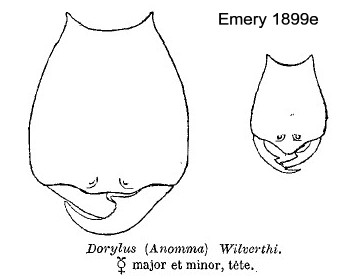 Emery's (1899e) description is at Emery's (1899e) description is at  ; Emery's (1901c) illustrated description
is at ; Emery's (1901c) illustrated description
is at  ;
Strand's (1911) description of the nigritarsis
queen is at ;
Strand's (1911) description of the nigritarsis
queen is at  . A set of illustrations of the queen and
workers by Forel (1912j) is at . A set of illustrations of the queen and
workers by Forel (1912j) is at  ; Santschi's (1935a) illustrated
description of nomadas (queen) is at ; Santschi's (1935a) illustrated
description of nomadas (queen) is at  . .
Emery's description was quoted in full by Raignier &
van Boven, 1955). My summary translation is - "Head, vis-a-vis arcens,
less elongated, sides less arcuate and the posterior angles each
prolonged into a raised point, slightly recurved outwards; these points
are present in all morphs but are strongest in the media. Posterior of
head deeply scalloped in an arc. The elongation of the head is
especially remarkable in the small examples which have the same
modifications of the clypeus and pubescence of all the Anomma".
Forel (1909b) describing a male collected by M. Luja in
company with "A. wilwerthi" workers, had - TL 26-30 mm, more red
and larger than that of nigricans, with longer and narrower
mandibles; the vertex also is a little more "bombÚ" - bulging or convex.
|
 I have to say that I am baffled
by the notes and illustration in Emery (1901c) of what he reported as
minima morphs with TL 3 mm and 9 antennal segments and TL 2.5 mm and 8
antennal segments respectively. Among the various species I have seen
and photographed, there does not appear to be any minima with less than
11 segments to the antenna. Emery gave no collection details and it
seems possible that the single specimen of each morph are
"contaminants", perhaps being Dorylus
(Alaopone) antinorii - as shown by Emery himself (1881a) but
transferred by me to Alaopone. I have to say that I am baffled
by the notes and illustration in Emery (1901c) of what he reported as
minima morphs with TL 3 mm and 9 antennal segments and TL 2.5 mm and 8
antennal segments respectively. Among the various species I have seen
and photographed, there does not appear to be any minima with less than
11 segments to the antenna. Emery gave no collection details and it
seems possible that the single specimen of each morph are
"contaminants", perhaps being Dorylus
(Alaopone) antinorii - as shown by Emery himself (1881a) but
transferred by me to Alaopone.
Wheeler (1922) had full-face illustrations of the head
of the soldier and a minor worker, showing the characteristic elongated
and divergent posterior corners of the head (right, drawing apparently
somewhat exaggerated).
|
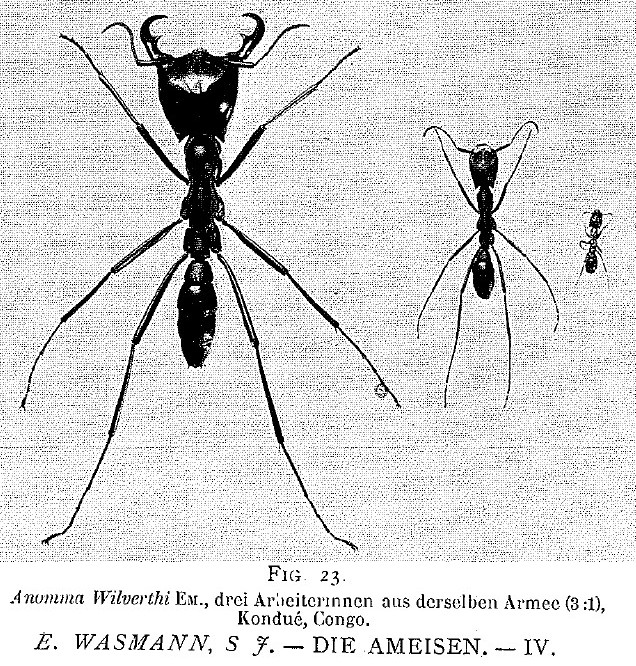 Also from Ivory Coast, at Ouossou (Talbot, in
Wheeler, 1922). Forel (1909b) reported workers from Kinshasa
[Leopoldville] by Lamarche, and Iringui by Lindemans. He also noted a
male, TL 26-30; from Mobeka, by Lothaire, being redder and larger than
that of nigricans, with the mandibles slightly longer and
straighter, also the vertex slightly more convex, bulging, the specimen
was found with workers of "wilwerthi". Bolton (1995) notes that
the name is frequently misspelt as wilwerthi but the real error
seems to lie in a misspelling, by Emery (1899)?, of the name of the
collector who seems definitely to have been Wilwerth; although
later in his paper, Forel (1909b) writes of "Plagiolepis fallax"
as collected by E. Wilverth. Towards the end of the same paper,
Forel, notes how, in August 1907, Luja collected the male with workers
on the same army, providing confirmation that his (Forel) description
of the male was correct. Also from Ivory Coast, at Ouossou (Talbot, in
Wheeler, 1922). Forel (1909b) reported workers from Kinshasa
[Leopoldville] by Lamarche, and Iringui by Lindemans. He also noted a
male, TL 26-30; from Mobeka, by Lothaire, being redder and larger than
that of nigricans, with the mandibles slightly longer and
straighter, also the vertex slightly more convex, bulging, the specimen
was found with workers of "wilwerthi". Bolton (1995) notes that
the name is frequently misspelt as wilwerthi but the real error
seems to lie in a misspelling, by Emery (1899)?, of the name of the
collector who seems definitely to have been Wilwerth; although
later in his paper, Forel (1909b) writes of "Plagiolepis fallax"
as collected by E. Wilverth. Towards the end of the same paper,
Forel, notes how, in August 1907, Luja collected the male with workers
on the same army, providing confirmation that his (Forel) description
of the male was correct.
It appears to be a forest species, commonest or even
restricted to areas of relatively low insolation, which gives for great
geographical scope in the Congo Basin, etc.Raignier & van Boven
(1955) found it to be by far the most common Anomma species at
Yangambi in Za´re; making 26 collections, from 19 nests, with a
total of 568 individuals. Their photographs of the head of the major
morph are shown below right.
Although they also reported two collections of sjostedtiwilverthi,
I suspect from the notes they give of the colonies being mixed, with
predominantly normal wilverthi specimens but a relatively small
number with reduced or absent teeth on the posterior corners of the
head, that what happens is that their findings, and the single finding
reported by Wasmann (from Grand Batanga, Cameroon), represent no more
than aberrant individuals of a standard wilverthi colony.
Wasmann himself (1916: 136) simply noted - "Ein exemplar
lag vor, von Geo Schwab bie Gro▀-Batang in Kamerun 11.7.1912 in einem
Zuge von Anomma sj÷stedti Em. var. Sj÷stedti-Wilverthi
(einer ▄bergangsform zwischen diesen beiden Rassen) gefangen. Ich
bennene die Art zu Ehren des Entdeckers".
Of course, one cannot rule out the occurrence of a
hybrid "species". Bolton (1995) has - "Subspecies of nigricans:
current status" without giving any authority.
|
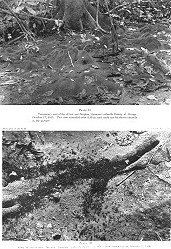
A series of worker sizes is illustrated in Schneirla (1971, page 25),
as ranging from TL 11.2 mm down to 3 mm. The queen may be TL 52 mm, and
lay some 1-2,000,000 eggs in her lifetime. The same author (largely
extracting from Raignier & van Boven, 1955) described the colony
size as 10-20 million, with a single queen. The nest was said to be
within 1-2 m below ground, often under the roots of trees with a
central mass. (see illustrations from Wheeler, 1992, "click" left").
Raiding takes place at dusk, less often at dawn and never at midday.
Emigration took place most frequently every 25 days or so, although a
stay could be as long as fifty days. The average of 26 migrating
columns showed a travel of 226 m, said to be the longest of all
dorylines, with the movement time averaging 34-38 hours, up to 57 hours
in duration. The effect of the movement results in a trench of notable
depth, effectively keeping the column below ground.
Raignier & van Boven (1955) have full descriptions
of the worker major, male and queen; with specimens of all from within
one nest and so definitively associated, unique (at least when they
wrote) for all known species of Anomma. They included
photographs (monochrome) of the male and female and these are
reproduced here.
|
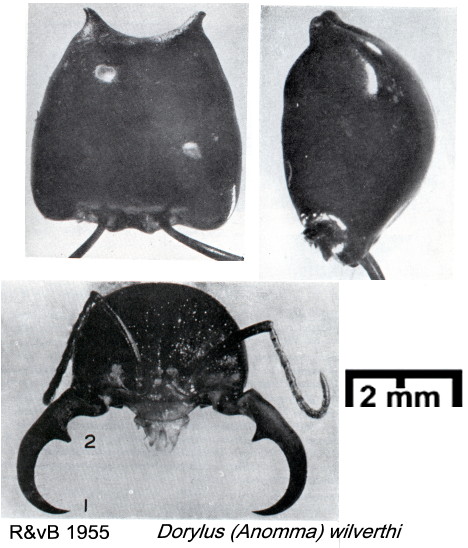 Full
description of major worker (translated from Raignier & van Boven,
1955) Full
description of major worker (translated from Raignier & van Boven,
1955)
Overall - head brown-black; mandibles, antennae and clypeus red-brown;
thorax, petiole and gaster red to red-brown; subpetiolar process dark
brown-black; gaster with black areas.
TL 12.38 HL 3.72 HW 3.64 HD 2.60 CI 98 SL 2.04 SI 55 AL 4.11 PW? PetL
1.13 PetW 0.92 GL? MFL ?
Head - widest at anterior; posterior border scalloped, posterior angles
extended and with a small lateral turned tooth (characteristic of the
species); median line a somber suture on the occiput, becoming a small
groove on the vertex; occiput, vertex and front shiny, @ 50 X light
reticulation is visible with very sparse puncturation; clypeal margin
recurved, with several long hairs, central hairs five times longer than
others; mandible slender and with apical tooth; basal tooth set just
behind the midpoint, no subapical teeth but internal border crenulated
and with hairs, external border glabrous and very finely reticulate;
central notch small but visible between frontal carinae and vertex;
scape slender (width about 1/8 of length) and slightly curved, finely
spiculated (recouvert de rÚticules chitineux) and with fine
pilosity, apex enlarged with several erect hairs; funiculus punctuate
all over and with tiny erect hairs, segment 2 slightly shorter than 1;
3-5 equisized, slightly longer than 6-9, 10 a club more than twice
length of 9; in profile height 70% of length.
Alitrunk - from above much narrower than the head; finely puncturate;
metanotal groove distinct but mesonotum barely distinguishable from the
propodeum; towards outer edge of propodeum there is a feeble depression
giving rise to divergent edges of the declivity; in profile metanotal
groove sharp, pronotum slightly above mesonotum; spiracle large;
metanotal gland with prominent upper flange terminating in a tooth.
Petiole - from above narrowed anteriorly, longer than wide, puncturate
and with several hairs, posteroventral processes small (but not a
consistent feature among colonies); laterally height about 60% of
length, spiracle well developed and raised; subpetiolar process
"scyphiforme" (variable in form and not a reliable diagnostic
character) with long hairs.
Gaster - five segmented, overall shape oval; terminal borders with long
hairs; basal half of first segment glabrous and shiny; sternites with
long hairs.
Legs - coxae finely puncturate; femora glabrous but with golden
pubescence; same on tibiae; tarsi with oblique erect hairs; total
length of hind legs 13.86 mm.
|
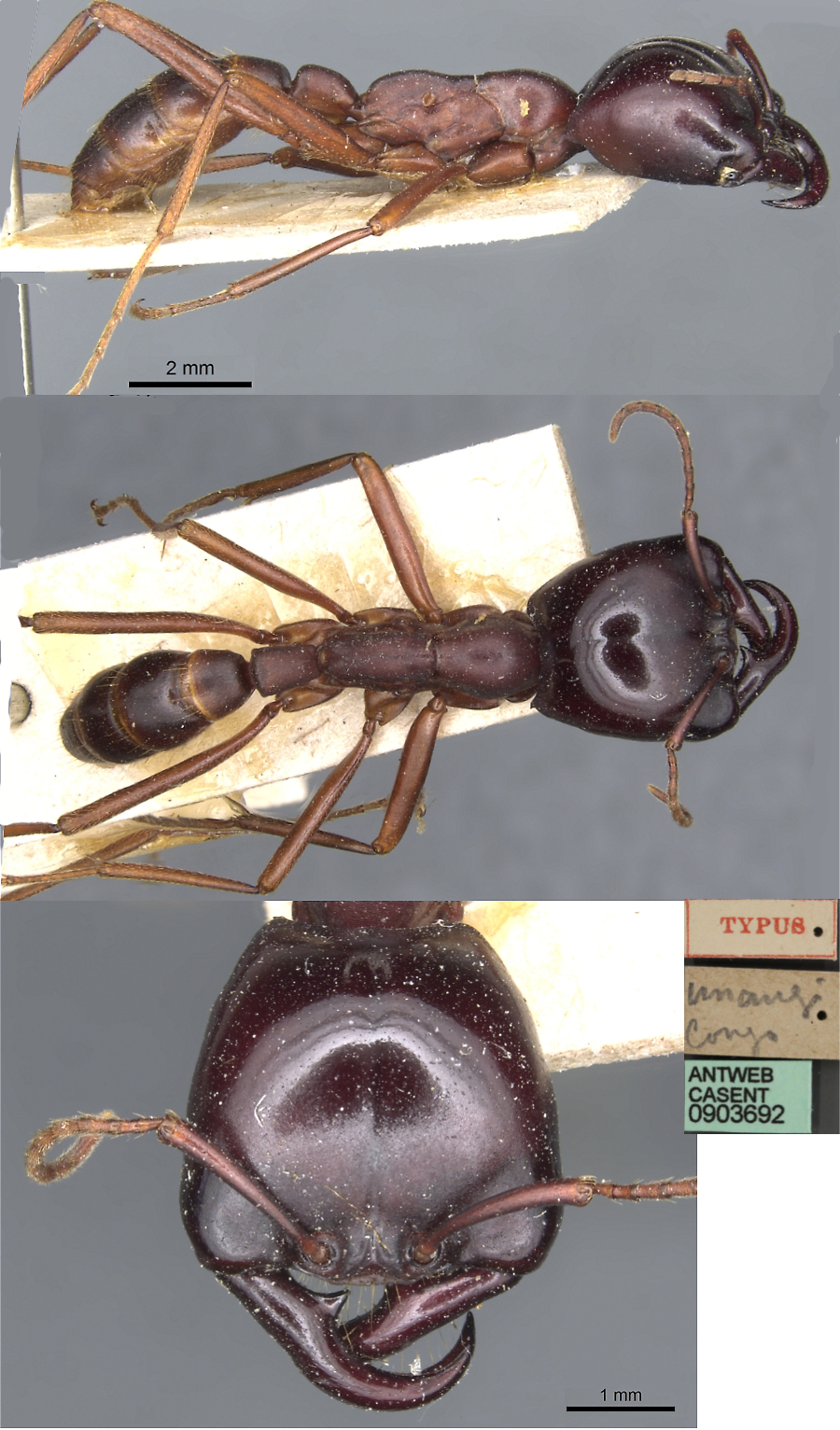 The
photomontage is
of the type major worker collated from http://www.antweb.org/specimen.do?name=casent0903692 The
photomontage is
of the type major worker collated from http://www.antweb.org/specimen.do?name=casent0903692
|
 The
photomontage is
of a type media worker collated from http://www.antweb.org/specimen.do?name=casent0903693 The
photomontage is
of a type media worker collated from http://www.antweb.org/specimen.do?name=casent0903693
|
Oxford University Museum
specimens
Dorylus (Anomma) wilverthi
B Taylor det.
Male
|
Central African
Republic
P Annoyer
|
16.vi.1998
Dzanga-Sangha
|
Bayanga-Lidjombo;
U.V. 19h-05h; LAYON PK 21 5.0 RCA
|
2
|
 |
Dorylus (Anomma) wilverthi
B Taylor det.
|
Uganda
C Hashimoto
0310103
|
30.x.2003
Kalinzu Forest
0░23'22.7" S
30░5'33.3" E
|
|
6
|
 |
Dorylus (Anomma) wilverthi
B Taylor det.
|
Uganda
S Uehara
III-85
|
19.xi.2002
Kalinzu Forest
0░23'22.7" S
30░5'33.3" E
|
In forest
|
1
|
|
Dorylus (Anomma) wilverthi
B Taylor det. |
Uganda
S Uehara
III-99
|
19.xi.2002
Kalinzu Forest
0░23'22.7" S
30░5'33.3" E
|
In forest
|
3
|
|
Dorylus (Anomma) wilverthi
B Taylor det. |
Uganda
S Uehara
III-137
|
23.xi.2002
Kalinzu Forest
0░23'22.7" S
30░5'33.3" E
|
Sawmill, in forest
|
4
|
|
|
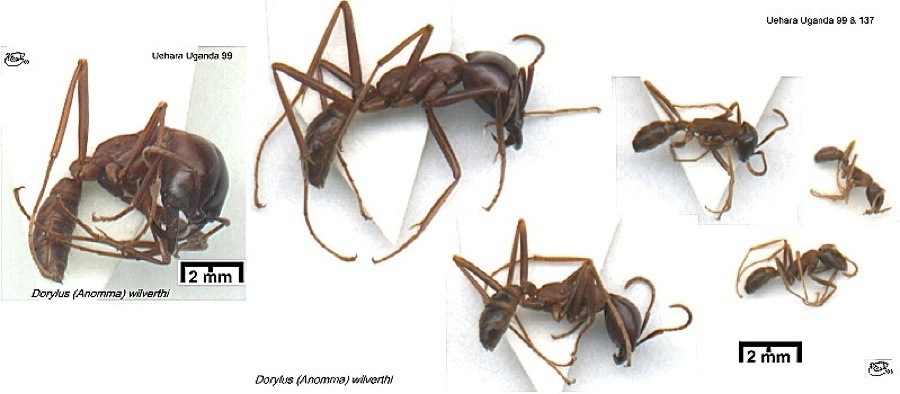 Polymorphism Polymorphism
In October 2003, Professor Shigeo Uehara sent me three
samples of wilverthi from the Kalinzu Forest, Uganda,
these were - III-85, of 19.xi.2002, W. of 519, in forest; III-89, of
19.xi.2002, W. of 430 (T4), in forest; III-137, of 23.xi.2002, Sawmill,
in forest. From those I was able to create this polymorphism montage
and the other photomontages. What is unusual is that the all the
morphs, even the very smallest, have the posteriorly narrowed head,
with distinct dorsolateral points.
The various morphs are shown in detail on the Dorylus (Anomma) wilverthi polymorphism
page. An Antweb media worker from CAR also is shown.
|
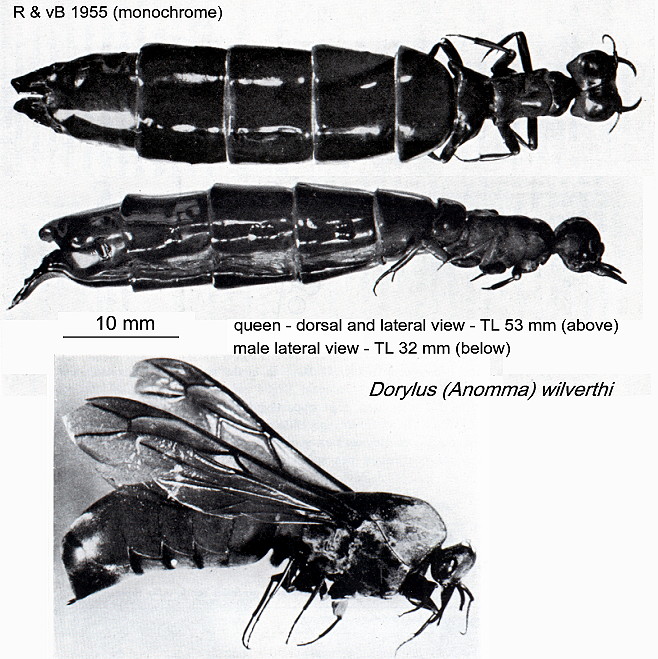 Sexual stages - Forel (1909b) describing a male
collected
by M. Luja in
company with "A. wilwerthi" workers, had - TL 26-30 mm, more red
and larger than that of nigricans, with longer and narrower
mandibles; the vertex also is a little more "bombÚ" - bulging or convex. Sexual stages - Forel (1909b) describing a male
collected
by M. Luja in
company with "A. wilwerthi" workers, had - TL 26-30 mm, more red
and larger than that of nigricans, with longer and narrower
mandibles; the vertex also is a little more "bombÚ" - bulging or convex.
A set of images of fresh males and the Forel (1912) "type" queen can be seen on the linked
page D. wilverthi males.
|
|